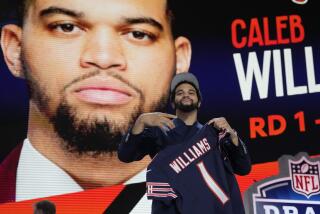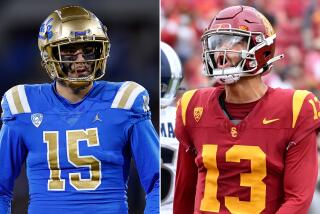1983 Stands Out as the Best Draft of the ‘80s
- Share via
If only it was 1983 again.
That’s how just about every NFL general manager and director of personnel feels about the draft in the last decade. If every crop of available college players was as talented and deep as it was in 1983, they might not have to spend every waking minute breaking down film, making personal scouting trips or checking out tips.
“The ’83 was a very deep draft,” says Dick Steinberg, player development director for the Patriots. “Not only the quarterbacks (six went on the first round). Curt Warner and Eric Dickerson were in that draft, too.”
Adds Jim Finks, now general manager of the Saints but, six years ago, the Chicago Bears’ team president:
“One year that jumps out at me is 1983. As an idea of the quality of player, Buffalo got Jim Kelly; Chicago, we got Jimbo Covert and Willie Gault. Cincinnati got Dave Rimington. Denver got Chris Hinton and Baltimore took John Elway and they made the trade of two quality players.
“Detroit got James Jones, who is still very productive. Houston got Bruce Matthews, a guard from Southern Cal. The Rams got Eric Dickerson, and Miami got Dan Marino. New England got Tony Eason, and the Jets got Ken O’Brien.
“To me, that draft stands out. A couple of those guys look to me as if they have a good opportunity to wind up in Canton, Ohio.”
If there was a Hall of Fame for drafts, 1983 certainly would be in it. Elway, Marino, Eason, O’Brien, Kelly and Todd Blackledge -- how did he get in there? -- were selected on a first round. Elway was the top pick, followed by Warner, Dickerson and Hinton. Darrell Green, Billy Ray Smith and Joey Browner also were first-rounders.
But you don’t measure the strength of a draft solely by the top 28 picks. Down in the eighth round, the Bears found Richard Dent. Cincinnati came up with Tim Krumrie in 10th and Denver discovered Karl Mecklenburg on the 12th and final round. All three have been All-Pros.
Not everyone prospered in ’83.
Pittsburgh’s first choice was Gabe Rivera, a massive defensive tackle from Texas A&M; who was paralyzed in an auto accident and never played for the Steelers. Pittsburgh got virtually nothing from that draft.
Kansas City, needing a passer, went for Blackledge of national champion Penn State when Marino, Kelly, Eason and O’Brien were around. Blackledge was a bust.
Overall, however, no group in this decade compares with ’83.
“We can only dream of coming up with another group like that one,” says Mike Hickey, who handles the draft for the Jets.
Hickey and the Jets were thrilled by last year’s grab bag, even though it was considered to lack substance beyond the first 50 players. If any team proved that wrong, it was the Jets, who got safety Erik McMillan, the defensive rookie of the year, and James Hasty, who could be just as good on the corner, in the third round.
“Lots of times, too much focus is put on the No. 1s,” Jets coach Joe Walton says. “The most important picks are the mid-rounds, when you can get some darn good football players, like we did last year.
“If we come out of this one with what we got last year, we’ll be smiling.”
A lot of folks were smiling coming out of the 1984 draft. In the second round, Cincinnati grabbed Boomer Esiason and Atlanta got Scott Case. Both went to this year’s Pro Bowl.
So have Fredd Young, whom Seattle drafted on the third round; Michael Carter, taken on the fifth by San Francisco; and Earnest Byner, a bargain basement pick for Cleveland on Round 10.
“Since 1984, none of them have been that strong,” Steinberg says. “I know that there’s been a smaller college-age population, which has affected a lot of industries, not only football. There’s also been a lot of injuries, not only in the pros but in college.
“A lot of football types are playing basketball, defensive ends and tight ends, because of the exposure basketball gets.
“Proposition 48 is a factor. ... Instead of practicing and working and developing for five years and playing for four, they’re only developing for three years. That’s two years lost.
“I’m sure that drugs and steroids are taking their toll, too.”
At the beginning of the 80s, drugs and steroids weren’t nearly as big an issue in football. But they have changed the complexion of the draft, Hickey says.
“You can’t afford to take a steroid-type,” Hickey says. “If he is (using) and gets caught, you’ve blown it. He could be lost to the team for some time and, when he gets off it, he’s a different guy.”
While the GMs and personnel people might yearn for the simpler days of earlier decades, they also keep in mind that it matters little how good an entire crop is as long as they pick the best of it.
“What turned out good for the New Orleans Saints,” Finks says of 1986, “particularly in the second and third rounds (Dalton Hilliard, Rueben Mayes and Pat Swilling), did not necessarily fall well for the other clubs. The one thing I have learned in the few campaigns I have been around is that none of them are a sure thing.”
Not even the Class of ’83.
But it was close.
More to Read
Go beyond the scoreboard
Get the latest on L.A.'s teams in the daily Sports Report newsletter.
You may occasionally receive promotional content from the Los Angeles Times.










